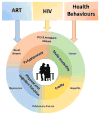HIV and ageing: improving quantity and quality of life
- PMID: 27367780
- PMCID: PMC5084838
- DOI: 10.1097/COH.0000000000000305
HIV and ageing: improving quantity and quality of life
Abstract
Purpose of review: Evidence-based strategies are needed to address the growing complexity of care of those ageing with HIV so that as life expectancy is extended, quality of life is also enhanced.
Recent findings: Modifiable contributing factors to the quantity and quality of life in adults ageing with HIV include: burden of harmful health behaviours, injury from HIV infection, HIV treatment toxicity and general burden of age-associated comorbidities. In turn, these factors contribute to geriatric syndromes including multimorbidity and polypharmacy, physiologic frailty, falls and fragility fractures and cognitive dysfunction, which further compromise the quality of life long before they lead to mortality.
Summary: Viral suppression of HIV with combination antiviral therapy has led to increasing longevity but has not enabled a complete return to health among ageing HIV-infected individuals (HIV+). As adults age with HIV, the role of HIV itself and associated inflammation, effects of exposure to antiretroviral agents, the high prevalence of modifiable risk factors for age-associated conditions (e.g. smoking), and the effects of other viral coinfections are all influencing the health trajectory of persons ageing with HIV. We must move from the simplistic notion of HIV becoming a 'chronic controllable illness' to understanding the continually evolving 'treated' history of HIV infection with the burden of age-associated conditions and geriatric syndromes in the context of an altered and ageing immune system.
Conflict of interest statement
Dr. Justice reports no conflict of interest. Dr. Reiss through his institution has received independent scientific grant support from Gilead Sciences, Inc., Janssen Pharmaceuticals Inc, Merck & Co, Bristol-Myers Squibb and ViiV Healthcare; he has served on scientific advisory board for Gilead Sciences, Inc.; he serves on data safety monitoring committee for Janssen Pharmaceuticals Inc; chaired a scientific symposium by ViiV Healthcare, for which his institution has received remuneration. Dr. Keri Althoff has served on scientific advisory boards for Gilead Sciences, Inc. Dr Mikaela Smit received consultancy fees from Gilead Science to present at the Advisory Board and HIV team meeting, and is receiving through her institution scientific grant support from Gilead Science.
Figures

References
-
- UNAIDS. The Gap report 2014 - People aged 50 years and older. 2014
-
- Legarth RA, et al. Long-Term Mortality in HIV-Infected Individuals 50 Years or Older: A Nationwide, Population-Based Cohort Study. J Acquir Immune Defic Syndr. 2016;71:213–218. This Danish study shows that although life expectancy amongst HIV-infected individuals over 50 years old has increased by more than 10 years from 1996–1999 to 2006–2014, it remains lower than the general population, even in those well treated and without comorbidity. - PubMed
-
- Marcus J, Chao C, Leyden WA, et al. Narrowing the Gap in Life Expectancy for HIV+ Compared With HIV− Individuals. CROI; Boston Massachusetts. 2016. Abstract #54.
Publication types
MeSH terms
Grants and funding
LinkOut - more resources
Full Text Sources
Other Literature Sources
Medical
Research Materials

